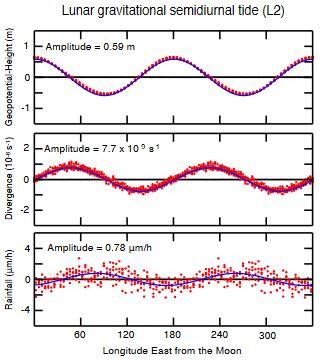Phase of the moon affects amount of rainfall

Satellite data over the tropics, between 10 degrees S and 10 degrees N, shows a slight dip in rainfall when the moon is directly overhead or underfoot. The top panel shows the air pressure, the middle shows the rate of change in air pressure, and the bottom shows the rainfall difference from the average. The change is 0.78 micrometers, or less than one ten thousandth of an inch, per hour. Credit: Tsubasa Kohyama/University of Washington
New University of Washington research to be published in Geophysical Research Letters shows that the lunar forces affect the amount of rain – though very slightly.
“As far as I know, this is the first study to convincingly connect the tidal force of the moon with rainfall,” said corresponding author Tsubasa Kohyama, a UW doctoral student in atmospheric sciences.
Kohyama was studying atmospheric waves when he noticed a slight oscillation in the air pressure. He and co-author John (Michael) Wallace, a UW professor of atmospheric sciences, spent two years tracking down the phenomenon.
Air pressure changes linked to the phases of the moon were first detected in 1847,and temperature in 1932, in ground-based observations. An earlier paper by the UW researchers used a global grid of data to confirm that air pressure on the surface definitely varies with the phases of the moon.
“When the moon is overhead or underfoot, the air pressure is higher,” Kohyama said.
Their new paper is the first to show that the moon's gravitational tug also puts a slight damper on the rain.
When the moon is overhead, its gravity causes Earth's atmosphere to bulge toward it, so the pressure or weight of the atmosphere on that side of the planet goes up. Higher pressure increases the temperature of air parcels below. Since warmer air can hold more moisture, the same air parcels are now farther from their moisture capacity.
“It's like the container becomes larger at higher pressure,” Kohyama said. The relative humidity affects rain, he said, because “lower humidity is less favorable for precipitation.”
Kohyama and Wallace used 15 years of data collected by NASA and the Japan Aerospace Exploration Agency's Tropical Rainfall Measuring Mission satellite from 1998 to 2012 to show that the rain is indeed slightly lighter when the moon is high. The change is only about 1 percent of the total rainfall variation, though, so not enough to affect other aspects of the weather or for people to notice the difference.
“No one should carry an umbrella just because the moon is rising,” Kohyama said. Instead, this effect could be used to test climate models, he said, to check if their physics is good enough to reproduce how the pull of the moon eventually leads to less rain.
Wallace plans to continue exploring the topic to see whether certain categories of rain, like heavy downpours, are more susceptible to the phases of the moon, and whether the frequency of rainstorms shows any lunar connection.
###
The research was funded by the National Science Foundation, the Tanaka Ikueikai Scholarship Society, and the Iizuka Takeshi Scholarship Foundation.
For more information, contact Kohyama at kohyama@uw.edu. Wallace is traveling out of the country through March.
Media Contact
All latest news from the category: Earth Sciences
Earth Sciences (also referred to as Geosciences), which deals with basic issues surrounding our planet, plays a vital role in the area of energy and raw materials supply.
Earth Sciences comprises subjects such as geology, geography, geological informatics, paleontology, mineralogy, petrography, crystallography, geophysics, geodesy, glaciology, cartography, photogrammetry, meteorology and seismology, early-warning systems, earthquake research and polar research.
Newest articles

First-of-its-kind study uses remote sensing to monitor plastic debris in rivers and lakes
Remote sensing creates a cost-effective solution to monitoring plastic pollution. A first-of-its-kind study from researchers at the University of Minnesota Twin Cities shows how remote sensing can help monitor and…

Laser-based artificial neuron mimics nerve cell functions at lightning speed
With a processing speed a billion times faster than nature, chip-based laser neuron could help advance AI tasks such as pattern recognition and sequence prediction. Researchers have developed a laser-based…

Optimising the processing of plastic waste
Just one look in the yellow bin reveals a colourful jumble of different types of plastic. However, the purer and more uniform plastic waste is, the easier it is to…



